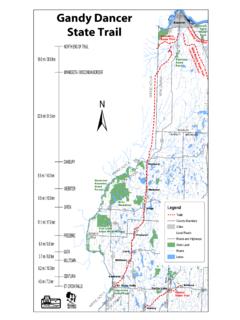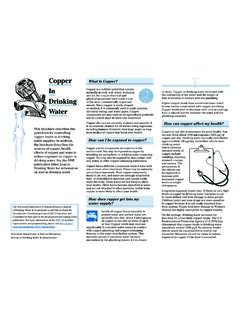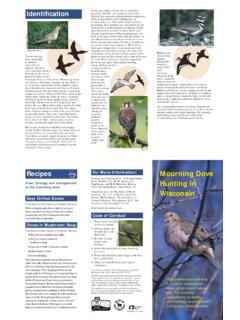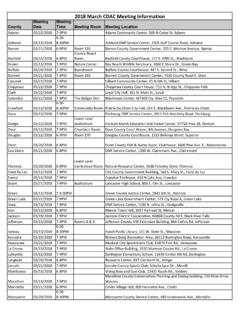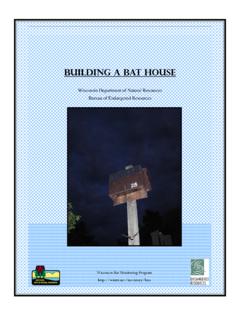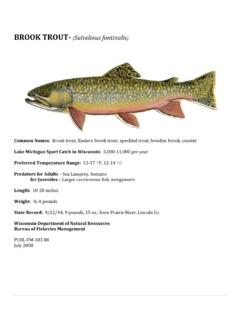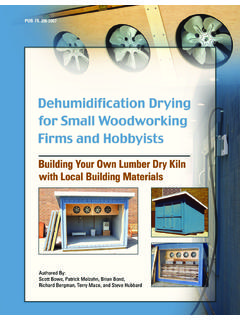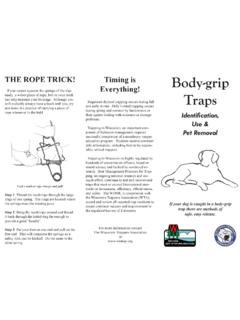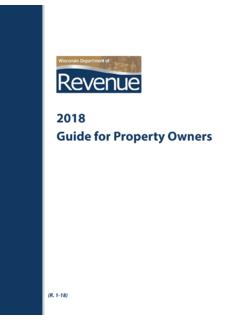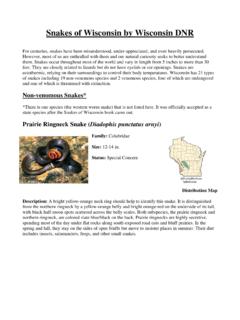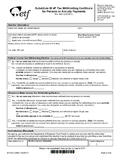Transcription of ' Wisconsin Lakes' PUB-FH-800 2005rev.
1 Wisconsin Department of Natural ResourcesPUB-FH-800 2009 Wisconsin LakesWisconsin Lakes Copyright 2009, Wisconsin Department of Natural ResourcesThis publication produced byBureau of Fisheries and Habitat ManagementThis publication funded in part bythe Aquatic Resources Trust Fund Sport Fish Restoration ProgramPrinted on Recycled PaperThe Wisconsin Department of Natural Resources provides equal opportunity in its employment,programs, services and functions under an Affirmative Action Plan. If you have any questions, pleasewrite to Equal Opportunity Office, Department of the Interior, Washington, publication is available in alternate format (large print, Braille, audio tape, etc.)
2 Upon request. Call608-267-7498 for more booklet is a public reference for Wisconsin lakes. It provides information onthe physical attributes of lakes such as the size, depth, type of public access,availability of lake maps, the relative abundance of fish species, exotic plants andanimals and information about fish consumption and data collected in the 1950s and 1960s by Department of NaturalResources field staff form the base of information for this publication. Continualfield work and input from staff and the public over the years provide updates onchanging conditions of some, but not all lakes listed publication will be updated periodically, to reflect the most current informa-tion available on Wisconsin s lakes.
3 Please notify the DNR field station nearest you(refer to the back cover) if you are aware of any omissions, errors, or changes thatrequire attention in the next edition of Wisconsin lake Web AddressesToday s access to the most current and extensive datasets and documents is on theWorld Wide s State Portal - s Home Page - s Lakes Information Source( Wisconsin Association of Lakes) Partnership in the DNR, UW-Ext., Citizen Lakes and WI Lakes Safety - Safety - Wisconsin - Michigan - - - - Permits - - Tourism - lake Information(North American lake Management Society) - Variability and DescriptionsEach lake has qualities which make it unique, much like people with distinctpersonalities.
4 Lakes vary based on physical characteristics, such as size, depth,configuration, chemical characteristics (such as soft versus hard water), waterclarity, or the types of plant and animal life present. For example, hard water lakeshave higher levels of dissolved minerals such as calcium, iron and magnesium thansoft water lakes. Some lakes, especially those near acidic wetlands like bogs, arestained with tannic acid that leaches from surrounding vegetation. The water inthese tannin lakes may range in color from a dark brown coffee color to lakes in Wisconsin frequently are classified by the source of water on water source and outflows, four categories of lakes have been identifiedin this publication:1.
5 Drainage lakes - These lakes have both an inlet and outlet where the main watersource is stream drainage. Most major rivers in Wisconsin have drainage lakesalong their course. Drainage lakes owing one-half of their maximum depth to a damare considered to be artificial lakes or Seepage lakes - These lakes do not have an inlet or an outlet, and onlyoccasionally overflow. As landlocked waterbodies, the principal source of water isprecipitation or runoff, supplemented by groundwater from the immediate drainagearea. Since seepage lakes commonly reflect groundwater levels and rainfallpatterns, water levels may fluctuate seasonally.
6 Seepage lakes are the most commonlake type in Spring lakes - These lakes have no inlet, but do have an outlet. The primarysource of water for spring lakes is groundwater flowing into the bottom of the lakefrom inside and outside the immediate surface drainage area. Spring lakes are theheadwaters of many streams and are a fairly common type of lake in Drained lakes - These lakes have no inlet, but like spring lakes, have acontinuously flowing outlet. Drained lakes are not groundwater-fed. Their primarysource of water is from precipitation and direct drainage from the surrounding , the water levels in drained lakes will fluctuate depending on the supplyof water.
7 Under severe conditions, the outlets from drained lakes may becomeintermittent. Drained lakes are the least common lake type found in LakesArtificial lakes are human-made bodies of water referred to as impoundments. Inthis publication, a lake is considered an impoundment if one-half or more of itsmaximum depth results from a dam or other type of control structure. An impound-ment is considered a drainage lake since it has an inlet and outlet with its principalwater source coming from stream drainage. Approximately 13 percent of Wisconsin slakes fit this Type CharacterizationsThe water quality of a lake and species of fish present are significantly influencedby the lake type.
8 For example, drainage lakes support fish populations which are notnecessarily identical to the streams connected to them. Drainage lakes, particularlyimpoundments, usually have higher nutrient levels than many natural seepage orspring contrast to drainage lakes, landlocked seepage lakes are not influenced bystreams. Consequently, seepage lakes frequently have a less diverse lakes also have a smaller drainage area, which may help to account forlower nutrient the Contents of this PublicationThis booklet contains information on all named lakes in Wisconsin and all unnamedlakes of more than 20 acres.
9 The lakes are listed alphabetically by county. Thefollowing notes may help you use this Name - The official name is listed according to Wisconsin GeographicalNames and as shown on Geological Survey 71/2 minute quadrangle lakes also have a different local name, which is listed in parenthesis after theofficial name. An asterisk (*) following the lake name indicates that the lake is aborder lake and is counted for total number of lakes and acreage in another Area - This column provides information on the lake size of a lake in acresof open water. For lakes that span state lines total acreage is given in the columnunder surface area and the Wisconsin acreage is listed in parenthesis after the lakename.
10 The area below the ordinary high water mark (OHWM), which is legally thelake's bed, may be a different Depth - The maximum depth in feet is recorded at the deepest point ina lake . All lakes in this publication should have a maximum depth Depth - The mean depth in feet is an average determined from the lakevolume and area. Not all lakes have a mean depth listed, only those with completedlake survey Access - Detailed access information is available for most counties in thestate. Many public fishing piers are now wheelchair-accessible. For information onspecific access sites, contact your nearest DNR office.
